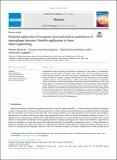DSpace Repository
Potential application of inorganic nano-materials in modulation of macrophage function: Possible application in bone tissue engineering
- DSpace Home
- →
- Web Of Science
- →
- Web Of Science
- →
- View Item
JavaScript is disabled for your browser. Some features of this site may not work without it.
| dc.contributor.author | Mohsen, Mofarrah
|
|
| dc.date.accessioned | 2024-05-04T07:13:33Z | |
| dc.date.available | 2024-05-04T07:13:33Z | |
| dc.date.issued | 2023 | |
| dc.identifier.issn | 2405-8440 | |
| dc.identifier.uri | http://hdl.handle.net/11547/11674 | |
| dc.description.abstract | Nanomaterials indicate unique physicochemical properties for drug delivery in osteogenesis. Benefiting from high surface area grades, high volume ratio, ease of functionalization by bio-logical targeting moieties, and small size empower nanomaterials to pass through biological barriers for efficient targeting. Inorganic nanomaterials for bone regeneration include inorganic synthetic polymers, ceramic nanoparticles, metallic nanoparticles, and magnetic nanoparticles. These nanoparticles can effectively modulate macrophage polarization and function, as one of the leading players in osteogenesis. Bone healing procedures in close cooperation with the immune system. Inflammation is one of the leading triggers of the bone fracture healing barrier. Macro-phages commence anti-inflammatory signaling along with revascularization in the damaged site to promote the formation of a soft callus, bone mineralization, and bone remodeling. In this re-view, we will discuss the role of macrophages in bone hemostasis and regeneration. Furthermore, we will summarize the influence of the various inorganic nanoparticles on macrophage polari-zation and function in the benefit of osteogenesis. | tr_TR |
| dc.language.iso | en | tr_TR |
| dc.title | Potential application of inorganic nano-materials in modulation of macrophage function: Possible application in bone tissue engineering | tr_TR |
| dc.type | Article | tr_TR |
Files in this item
This item appears in the following Collection(s)
-
Web Of Science [1152]
